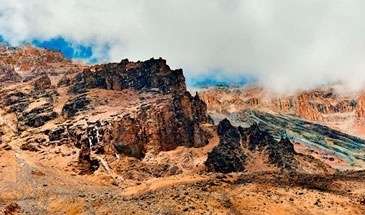
The 7 Days Umbwe Route is the toughest route to the summit of Kilimanjaro.
If you’re an experienced, bold climber you’ll relish challenging yourself on the unforgiving but uncrowded and beautiful terrain.
You’ll enjoy breathtaking sights that few travelers see. You’ll experience the raw, primitive beauty of sun-bleached rocky outcrops and balance along knife-edge ridges with water-carved ravines swooping giddily below.
You’ll clamber upon the gnarled tree roots of ancient rainforest trails, traverse ice fields shimmering like frosted diamonds in the African sun, and sleep under sweeping star-filled skies. As you stand proudly on Uhuru Peak at sunrise, you can say that you have conquered Umbwe.
Facts About Umbwe route.
This might be your arrival day in Tanzania, our driver will pick you from the airport preferred Kilimanjaro International Airport and drive you to the hotel for overnight.
Your day starts early with a briefing, followed by breakfast and an hour drive from Moshi/Arusha to Umbwe Village (1,490 m/4,890 ft) where your guides and porters pack your equipment and supplies, and give you a lunch pack. You start your ascent at the small Umbwe Gate just above the village and follow a gentle winding vehicle track for an hour to a signboard that announces the small steep Umbwe trail.
forest glades to Giant Erica, Heather, and drier air. You continue up a ridge that drops steeply on both sides, and hopefully, the clouds will part to reward you with a view of Uhuru Peak looming overhead. After lunch, you enter a zone of giant groundsels (Seneci Kilimanjari) that seem to guard the heights, and this garden is one of Kilimanjaro’s special treasures.
After breakfast, we continue up a steep ridge to the great Barranco Wall, then you climb this imposing obstacle, which turns out to be easier than it looks. Topping out just below the Heim Glacier, you can now appreciate just how beautiful Kilimanjaro really is.
In the morning you hike east over the intervening ridges and valleys to joining mweka route which will be your decent route.
– Summit Day!
You will rise around 11:30 PM, and after some steaming tea and biscuits, you shuffle off into the night.
Your 6- hour climb northwest up through heavy scree between the Rebmann and Ratzel glaciers to Stella Point on the crater rim is the most challenging part of the route for most climbers. At Stella Point (5,685 m/18,650 ft) you stop for a short rest and a chance to see asupremely sanguine sunrise. At Stella Point you join the top part of the Marangu Route, but do not stop here too long, as it will be extremely difficult to start again due to cold and fatigue.
Depending on the season and recent storms, you may encounter snow on your remaining hike along the rim to Uhuru Peak. On the summit, you can enjoy your accomplishment and know that you are creating a day that you will remember for the rest of your life. After your 3-hour descent from the summit back to Barafu Camp, you will have a well-earned but short rest, collect your gear, and hike down a rock and scree path into the moorland.
After a well-deserved breakfast, it is a short, scenic, 3- hour hike back to the Mweka gate. At the gate, you can sign your name and add details in a register. This is also where successful climbers receive their summit certificates. Climbers who reached Stella Point are issued green certificates and those who reached Uhuru Peak receive gold certificates. From the Mweka Gate, you will continue down to the Mweka Village, possibly a muddy, 3 km, 1 hour hike if the road is too muddy for vehicles.

Please note:
All accommodation is on sharing basis (i.e. you will be sharing with your travel companion a twin/double room in the hotel and a tent during the hike. If you travel alone, we will match you with a same-sex adventurer).